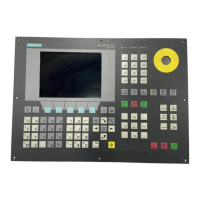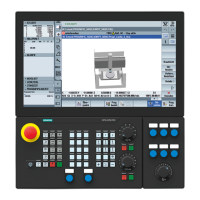Flexible NC programming
1.15 Axis replacement, spindle replacement (RELEASE, GET, GETD)
Job planning
Programming Manual, 07/2010, 6FC5398-2BP40-0BA0
125
1.15 Axis replacement, spindle replacement (RELEASE, GET, GETD)
Function
One or more axes or spindles can only ever be interpolated in one channel. If an axis has to
alternate between two different channels (e.g., pallet changer) it must first be enabled in the
current channel and then transferred to the other channel. Axis replacement is effective
between channels.
Axis replacement extensions
An axis/spindle can be replaced either with a preprocessing stop and synchronization
between preprocessing and main run, or without a preprocessing stop. Axis replacement is
also possible via:
● Axis container rotation AXCTSWE or AXCTWED using implicit
GET/GETD
● Frame with rotation if this process links the axis with other axes.
● Synchronized actions, see Motion-synchronous actions, "Axis replacement
RELEASE, GET".
Machine manufacturer
Please refer to the machine manufacturer's instructions. For the purpose of axis replace-
ment, one axis must be defined uniquely in all channels in the configurable machine data
and the axis replacement characteristics can also be set using machine data.
Syntax
RELEASE (axis name, axis name, ...) or RELEASE (S1)
GET (axis name, axis name, ...) or GET (S2)
GETD(axis name, axis name, ...) or GETD(S3)
With GETD (GET Directly), an axis is fetched directly from another channel. That means that
no suitable RELEASE must be programmed for this GETD in another channel. It also means
that other channel communication has to be established (e.g. wait markers).
Significance
RELEASE (axis name, axis name, etc.): Release the axis (axes)
GET (axis name, axis name, etc.): Accept the axis (axes)
GETD (axis name, axis name, etc.): Directly accept the axis (axes)
Axis name: Axis assignment in system: AX1, AX2, ... or
specify machine axis name
RELEASE(S1) : Release spindles S1, S2, ...
GET(S2) : Accept spindles S1, S2, ...
GETD(S3) : Direct acceptance of spindles S1, S2, ...

